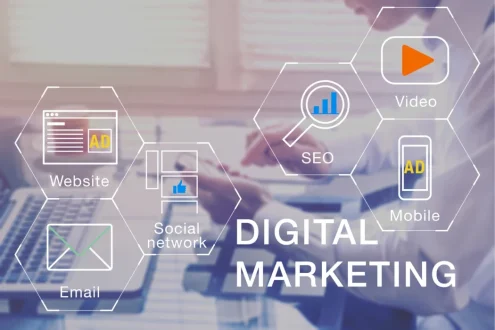
What Is Digital Marketing? Types and Examples
In today’s digitally driven world, marketing has evolved beyond traditional methods to encompass a wide array of online strategies and techniques. Digital marketing is the practice of promoting products, services, or brands via electronic media, primarily on the internet. This article explores what digital marketing is, the various types of digital marketing, and provides examples to illustrate each type. What Is Digital Marketing? Digital marketing refers to the use of digital channels, platforms, and technologies to reach consumers. This form of marketing is data-driven, allowing businesses to tailor their strategies based on customer behavior, preferences, and engagement. Digital marketing encompasses a broad spectrum of activities, from search engine optimization (SEO) and content marketing to social media and email marketing. Types of Digital Marketing 1. Search Engine Optimization (SEO) SEO involves optimizing your website and content to rank higher in search engine results pages (SERPs). The goal is to increase organic (non-paid) traffic to your site by improving its visibility for relevant searches. Example: A local bakery optimizing its website for keywords like “best bakery in [City]” to appear at the top of search results when someone searches for bakeries in that area. 2. Content Marketing Content marketing focuses on creating and distributing valuable, relevant, and consistent content to attract and retain a clearly defined audience. The ultimate goal is to drive profitable customer action. Example: A fitness brand maintaining a blog with articles on workout routines, nutrition tips, and wellness advice to engage and educate its audience. 3. Social Media Marketing Social media marketing involves promoting your brand and content on social media platforms to increase brand awareness, drive traffic, and generate leads. Example: A fashion retailer using Instagram to showcase its latest collections, engage with followers through stories and posts, and run targeted ads. 4. Pay-Per-Click (PPC) Advertising PPC is a model of internet marketing in which advertisers pay a fee each time one of their ads is clicked. It’s a way of buying visits to your site rather than attempting to earn those visits organically. Example: A software company running Google Ads campaigns to target potential customers searching for software solutions. 5. Email Marketing Email marketing involves sending commercial messages to a group of people using email. It’s an effective way to nurture leads, keep customers engaged, and promote products or services. Example: An e-commerce store sending personalized emails with product recommendations, discounts, and updates to its subscriber list. 6. Affiliate Marketing Affiliate marketing is a performance-based marketing strategy where a business rewards affiliates for each visitor or customer brought by the affiliate’s own marketing efforts. Example: A travel company partnering with bloggers who promote travel packages on their blogs and earn a commission for each booking made through their referral links. 7. Influencer Marketing Influencer marketing leverages individuals with a large following on social media to promote products or services. These influencers have the power to affect the purchasing decisions of others because of their authority, knowledge, or relationship with their audience. Example: A skincare brand collaborating with a popular beauty influencer to review and endorse its new product line. 8. Mobile Marketing Mobile marketing focuses on reaching customers on their mobile devices through SMS, MMS, apps, and mobile-friendly websites. This type of marketing is increasingly important as more consumers use their phones for shopping and browsing. Example: A restaurant sending SMS coupons to customers for a discount on their next meal. 9. Video Marketing Video marketing involves using video content to promote or market your brand, product, or service. It can include tutorials, testimonials, live videos, and more. Example: A tech company producing how-to videos on YouTube to help customers understand how to use their products. 10. Online Public Relations (PR) Online PR is about securing online coverage with digital publications, blogs, and other content-based websites. It’s similar to traditional PR but in the online space. Example: A new startup issuing a press release about its launch and getting featured in major online tech publications. Conclusion Digital marketing is an essential component of modern business strategy. By leveraging various digital channels and techniques, businesses can reach a wider audience, engage with customers more effectively, and drive growth. Understanding the different types of digital marketing and how to apply them can help you create a comprehensive and effective marketing plan tailored to your business goals. Enquiry Services
Read More
Understanding Open Graph and Its Benefits for Google SEO
Introduction to Open Graph Open Graph is a protocol developed by Facebook that allows web pages to become rich objects in a social graph. It enhances the way your content is displayed on social media platforms by defining specific meta tags that dictate how URLs are presented when shared. By implementing Open Graph tags, you ensure that your content appears more attractive and engaging, increasing the likelihood of clicks and shares. Benefits of Open Graph Implementing Open Graph Tags To implement Open Graph tags, you need to add specific meta tags to the HTML of your webpage. Here are the essential Open Graph tags you should include: <meta property=”og:title” content=”Your Page Title Here” /> <meta property=”og:description” content=”A brief description of your page content.” /> <meta property=”og:image” content=”https://www.example.com/image.jpg” /> <meta property=”og:url” content=”https://arizvandi.com/blog-rizvandi /> <meta property=”og:type” content=”website” /> Best Practices for Open Graph Conclusion Open Graph is a powerful tool for enhancing the social sharing of your content, leading to increased engagement and traffic. By implementing and optimizing Open Graph tags, you not only improve the appearance of your links on social media but also contribute to your overall SEO strategy. Ensuring that your content is visually appealing and accurately described can lead to better user experiences, higher click-through rates, and ultimately, better search engine rankings. Investing time in properly setting up Open Graph tags is a step towards a more effective and integrated digital marketing strategy.
Read MoreDigital Marketing and Information technology
Is information technology essential for the implementation of digital marketing strategies? Is information technology essential for the implementation of digital marketing strategies? Absolutely! Digital marketing and information technology (IT) are interdependent. IT plays a pivotal role in the realm of digital marketing, offering indispensable support for data analysis, enhancing user experience, managing online systems, and optimizing overall efficiency. Data analysis, user experience, advertising efficiency, customer relationship management (CRM) systems, and content marketing are all areas where information technology contributes significantly to digital marketing. Leveraging systems and data analysis software, innovative technologies, online advertising tools, CRM software, and harnessing technology for the creation, organization, and distribution of diverse and compelling content are all made possible with IT. In essence, information technology serves as the backbone, providing indispensable tools crucial for the successful execution of digital marketing strategies. Without IT, digital marketing would not be nearly as effective, efficient, or innovative. Amir Rizvandi
Read MoreHow to create canonical tag in laravel website?
How to create canonical tag in laravel website? Creating a canonical tag in a Laravel website involves adding a <link> tag to the <head> section of your layout file. The rel attribute of the tag should be set to “canonical”, and the href attribute should be set to the URL of the page you want to specify as the canonical version. Here is an example of how to add a canonical tag to a Laravel website: <head> <link rel=”canonical” href=”{{ url()->current() }}” /> </head> This code will add a canonical tag to every page in your Laravel website. If you want to add the canonical tag to only specific pages, you can use an if statement to check the current URL. Here is an example of how to add a canonical tag to only the homepage of your Laravel website: <head> @if (url()->current() === url(‘/’)) <link rel=”canonical” href=”{{ url(‘/’) }}” /> @endif </head> You can then use the canonicalUrl() helper function to add the canonical tag to your layout file: <head> <link rel=”canonical” href=”{{ canonicalUrl(request()) }}” /> </head> This code will add a canonical tag to every page in your Laravel website, and the canonical URL will be generated based on the current URL. #Laravel #SEO #HTML #tag #canonical Amir Rizvandi
Read More